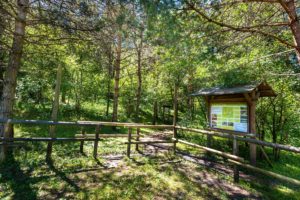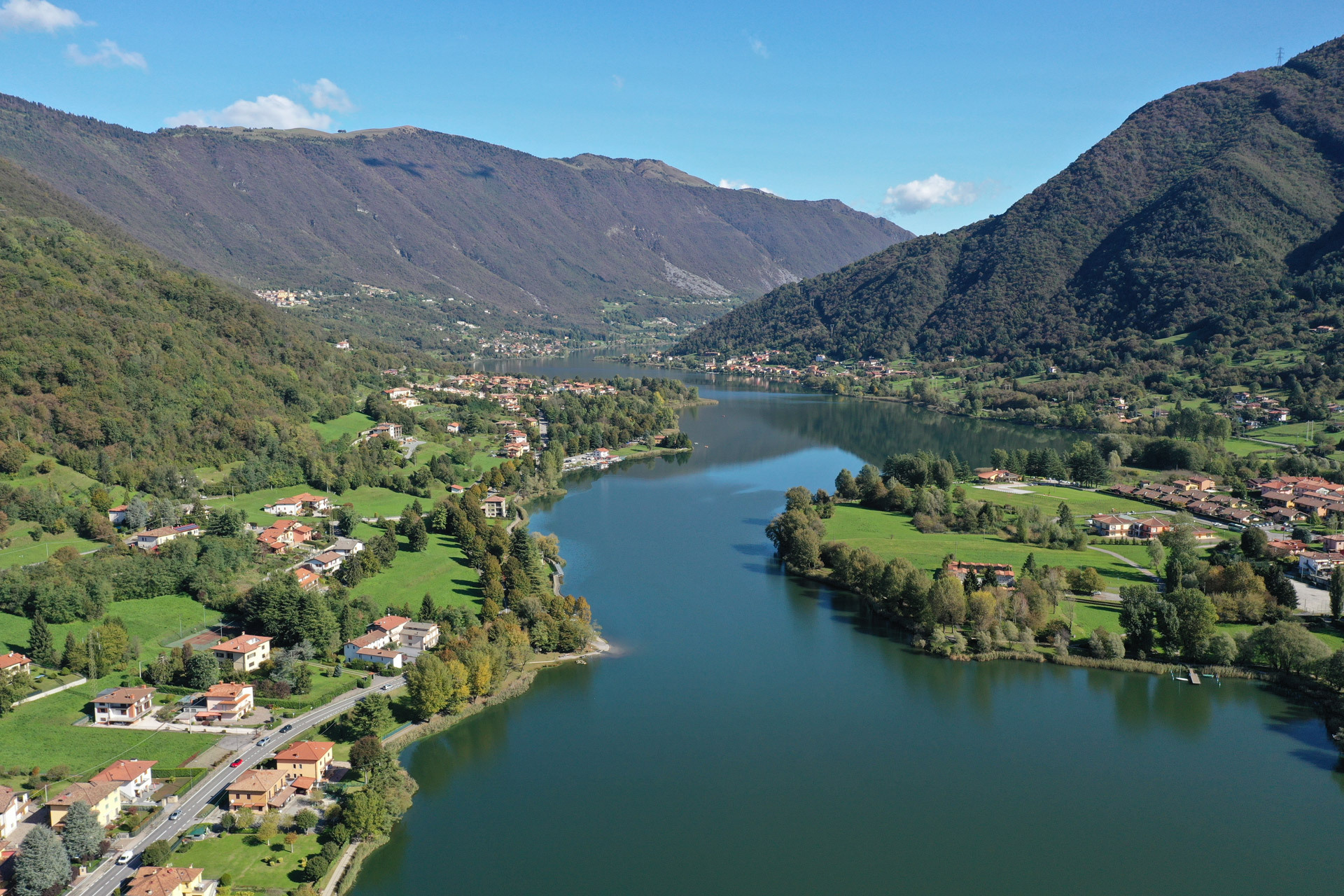You will find all the fascination of mountain flora and fauna without endless hours of climbing. This environmental rarity with Europe’s unique microclimate is a true natural refrigerator. You do not need crampons to admire edelweisses and gentians in the Valle del Freddo: normally, you would only encounter them along the trails at more than 1700 metres above sea level. Instead, here you will find them only 360 metres above sea level in the surroundings of Solto Collina. Environmental merit and an alpine temperature are the perfect combination for this summer nature exploration…in the company of a sweatshirt!
After the glacier receded 20.000 years ago, this area near the Gaiano pond remains a wonderful corner of the mountains at low altitudes. This fascinating place with its delicate Alpine microclimate can be visited every year, from May to July, by following a path through hornbeams and hazels.
Here in Valle del Freddo, there is no need to turn on the air conditioner even in mid-August. A unique climatic condition is created here: in summer, air streams around 2° to 4° come out of the holes at the bottom of the valley. Moreover, they are cooled thanks to the passage through the large blocks of ice, created underground in winter.
The discovery of the valley came about thanks to an edelweiss. Botanist Guido Isnenghi found it in 1939 following the indications of a hunter who wore the harvested flower on his hat without climbing to altitude.
Gentians, Heather, and Globularia are some of the other flower species that can be admired along with the thousands of colours of the wild Orchids growing in the valley: from fuchsia to brown, to white, to the deep green of the Listera Ovata, a species that reaches up to 60 centimetres in height.
To keep you company if you are quiet enough during your visit there will also be foxes, squirrels, weasels, and hares. And with your head up, you will be able to see finches, robins, hoopoes, and titmice: just in case they do not want to look out over the foliage, you can always hear them singing while you enjoy the coolness… without boots and chopsticks!
FOR VISITS AND RESERVATIONS, CALL +39 3487596650
Duration of visit: 90′ approx.
BRIEF INFORMATION:
Some information on the Valle del Freddo
To all appearances, it would seem to be a simple depression located in Upper Val Cavallina in the territory of the municipality of Solto Collina, 360 metres above sea level. However, the Valle del Freddo hides something extraordinary. The botanist Guido Isnenghi was the first to notice this, when in 1939, passing through Piangaiano, he saw an edelweiss (typical of altitudes above 1700 metres) on the hat of a hunter, who claimed to have collected it in the area where the reserve is now located. The sceptical botanist went to the area, and he was able to ascertain the presence of several other botanical species typical of high altitudes. Since that moment, numerous researchers and experts have begun studies on this phenomenon.
The natural phenomenon
The natural phenomenon reserve encompasses a unique microclimatic phenomenon that causes typical high mountain flora to grow at a modest height. This phenomenon is due to the freezing air (2°-4° C) coming from some “cold holes” or “mouths”.
A peculiar soil structure means that in winter when it rains and snows, water and snow penetrate the subsoil, where they come into contact with cold gravel and turn into ice. The debris keeps the temperature of the air that flows in low and then escapes through the vents.
The Valle del Freddo is therefore characterised by two types of weather: a general climate and the “microclimate” present in the microthermal zone, where the cold air escapes. Consequently, this determines the presence of four different environments: the coppice forest consisting of broad-leaved trees such as hazelnut tree, flowering ash, and black hornbeam, and the pine forest consisting of scots pine. In the arid grasslands, some species live on shallow, arid soils. In the macereto one can find Saponaria, Erba regina, Swiss Selaginella and Sheuchzer’s Raponzolo. Measurements made by the scholar Luigi Fenaroli in 1962 recorded a temperature difference of as much as 27° between the atmosphere in the valley and the air coming from the mouths!
The flowers of the cold
Thirty-two plant species characteristic of the Alpine climate, such as Edelweiss, Chamois Grass, Alpine Camedrio, and Alpine Plangiucola, have been found at the bottom of the valley. Shrubs such as Rhododendrons, Pinus Mugo, and Willow Stipolato are widespread.
In spring, extensive blooms of Gentian, Heather, Thyme, and Globularia cover the slopes of the valley. Further up, the Raven Pear and Hawthorn bloom. Additionally, there is the rare and beautiful Wild Peony, while Cyclamen and Red Valerian are more common. Finally, worthy of note is the Listera ovata, a 30-60 cm tall orchid, characterised by small greenish-yellow flowers.
Fauna
The vegetation offers shelter to numerous species of animals: hares, weasels, foxes, and badgers. Dormice, hazel mice, and squirrels make their nests in the hollows of old trees. The forest is also rich in birds: blackbirds, great tits, chaffinches, shrikes and greenfinches. Less common are the jay, hoopoe, and cuckoo.
Nocturnal birds of prey include the little owl and the owl, while the lonely sparrow is a rarity.
Reptiles also populate the Valle del Freddo in large numbers: the viper, the whip snake, the Austrian Coronella, and the Aesculapian columbro.
Visits
The Valle del Freddo can be visited during May, June, and July, naturally along a suitable path, outside of which it is not permitted to go.

The regulations
Access to the Reserve is regulated by Regional Council Resolution n. 7/19213 of 29.10.2014, which states that it is forbidden to:
- Collecting, removing or damaging wild flora;
- Lighting open fires;
- Disturbing, damaging, capturing or killing wild animals, collecting or destroying their nests, burrows or bedding, damaging or destroying their environment;
- Hunting;
- Engaging in grazing;
- Introducing dogs;
- Introducing extraneous animal or plant species;
- Carrying out advertising activities, organising folklore or sporting events, camping;
- Going with motorised vehicles;
- In particularly worthy areas identified by the plan, leave the beaten track;
- Carrying out studies or research that involve taking parts of the environment or other exceptions to the prohibitions;
- Carrying out any other activity, even of a temporary nature, as indicated in the plan, that involves alterations to the quality of the environment that are incompatible with the purpose of the Reserve.
The Management Plan in force provides for the following prescriptions, in addition to the regulations indicated above:
Cold Zone (Zone A) – Microthermal Process Zone (Zone B)
- Prohibition of access;
- Prohibition to leave the indicated and beaten paths.
Regulations for visits
- Visits to the public are permitted in zones A and B only on foot, accompanied by authorised personnel, in groups of no more than 15 people, and for a maximum number of 100 visitors per day during May – June and July on the following days and times:
– Saturday from 1.30 p.m. to 6 p.m., Sunday from 9 a.m. to 12 p.m. / 1.30 p.m. to 6 p.m;
– Monday to Friday: visitors are required to book their visit at the offices of the Comunità Montana Alto Sebino (managing authority of the Reserve); - Access to the remaining reserve areas C and D is free all year round, on foot only;
- The rules of the Reserve must be respected during the visit; in the event of infringements, the person responsible, in addition to incurring the prescribed penalties, will be expelled from the Reserve;
- Visits to the Cold Zone for scientific reasons are allowed, subject to a reasoned request to be sent at least two months in advance to the Director of the Reserve, who, in compliance with the Permanent Advisory Commission, will give an irrevocable reply.

